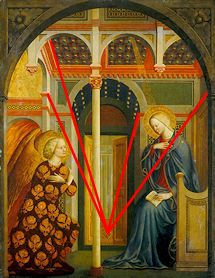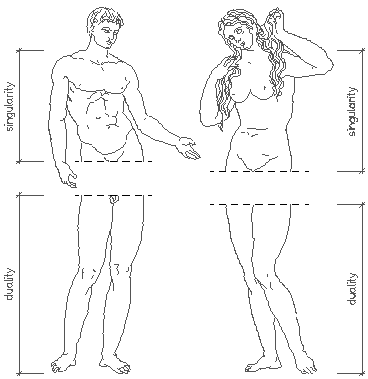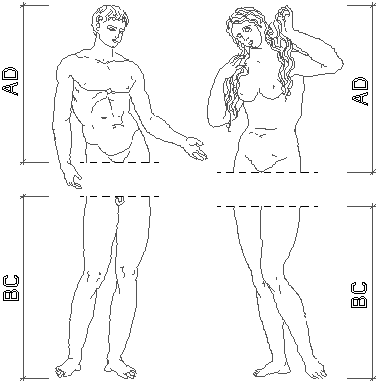Stephen Lauf
The Timepiece of Humanity
The Calendar Incarnate
Annunciation
Duality 1
Duality 2
The Metaphor
The Timepiece of Humanity
The Gauge
Chronosomatically Contemplating the Naval
| |
metaphor
: a figure of speech in which a word or phrase denoting one kind of object or action is used in place of another to suggest a likenees or analogy between them : an implied comparison in contrast to the explicit comparison of the simile
transcend
1 : to rise above or go beyond the limits of : EXCEED b : to extend above or beyond (as the universe) : 2 : to outstrip or outdo in some attribute, quality, or power : SURPASS : 3 obs : to cross or climb over : MOUNT : 4 : to cause to rise or go upward : ELEVATE, RAISE : ~ vi 1 obs : to travel upward or onward : ASCEND 2 : EXCEL, SURPASS
center
1 a : the point around which a circle or sphere is described : the point equidistant from all points on a circumference; broadly : MIDDLE : the point at an average distance from the exterior angles, points, or lines of a figure or body : b archaic : the middle point of the earth : 2 : a point around which things revolve; often : a focal point for attraction, concentration, or activity : a point, area, person, or thing that is most important or pivotal in relation to an indicated activity, interest, or condition a : PIVOT, AXIS b: a point, area, person, or thing upon which attention, feeling, or action converges : FOCUS c : a place, area, person, group, or concentration marked significantly or dominatingly by an indicated activity, pursuit, interest, or appeal d : a source or point of origin for an influence, force, process, action, or effect : HEART : a vital or stimulating factor

The perspective lines of the architectural setting converge upon a diamond inlaid at the base of Mary's bed. The inward sequence of column, passage, and bedroom symbolically suggests the sexual union of phallus, passage and womb.
"Therefore the Lord himself will give you this sign: the virgin shall be with child, bear a son, and shall call him Emmanuel."
Isaia 7:14
We write: "Anno Domini 1951." This means that we measure time from a center. This determines the time that follows it, and the time which preceded it strove toward this center. Our historical numbering of the years tacitly presupposes a ceasura between the era before the birth of Christ and the era which came after it. Our history is oriented toward a center.
Gilles Quispel, "Time and History in Patristic Christianity." (Rhein-Verlag, Zurich, 1951). Cf. Joseph Campbell, ed., Time and Man, Papers from the Eranos Yearbooks, (New York: Princton/ Bollinger, 1983), p.85.
| |
The Metaphor
The foremost duality of an individual body1, either male or female, is the composite pair of legs and feet, and the foremost singularity of an individual body is the torso. The legs and feet constitute half of the body's height, and it is at precisely this halfway point that the body's foremost duality transcends into the body's foremost singularity. Two become one at the center of the body.
The foremost duality of humanity is the separation of male and female, and, if the conclusion drawn by Aristophane's myth is to be believed, the foremost singularity of humanity is the union of male and female. The physical manifestations of the sexual duality and the transcendence of the sexual duality into singularity coincide at the same point on the human body. The point of sexual transcendence is also the same as the point where the legs become the torso. Again, two become one at the center.
The notion of two becoming one has been with humanity since the beginning, and is, indeed, at the very center of human existence. That physical and sexual transcendence from two to one occurs at the same point, and that that point is also the center of the body is not only significant, it inspires a powerful metaphor where the human body ultimately comes to symbolize the totality of time.
The story of the Annunciation is essentially about the union of God and humanity, yet the story is also about the union of male and female. Masolino da Panicale's painting, The Annunciation is poised exactly on the moment when the duality of God and humanity, through the Incarnation of Jesus Christ, is about to merge as one. The painting, however, also symbolically represents the union of male and female. As much as the column in the painting represents the last moment of division and separation, it carries sexual implications as well. The column stands firmly in front of the archway and open doors that lead to Mary's bedroom, and the perspective lines of the painting's entire architectural setting come to a vanishing point at the bottom tip of the diamond inlaid along the base of Mary's bed. Subliminally, the column is the phallus, the archway is the passage, and the bedroom is the womb. The references to sexual union do not end here, however. The base of the column just barely touches the golden hem of Mary's cloak, intimating the slightest of contact. Furthermore, it is the Book of Isaia that is open on Mary's lap. The words "Ecce virgo concipiet..." are right next to Mary's womb, exactly where the conception of Christ, the Incarnation, actually takes place. By dealing with all these factors collectively, Masolino's Annunciation is everything a painting of the Annunciation should be. The notion that a basic duality is about to end, and that the unification of God and humanity will begin through the Word of God fertilizing the egg within the Virgin's womb is portrayed throughout.
Christ becomes flesh at the Incarnation, but it is not until Christ's birth, nine months later, that God becomes a truly individual human being. Christ's birth fulfills the process of God and humanity's transcendence into singularity which began at the Annunciation. The effect of Christ's birth, besides, of course, Christianity, is still present every day of the calendar year. The current numbering of years considers year "1" as the first year of Christ's life. Until the recent political correctness movement (in the United States of America), A.D. or Anno Domini - Year of Our Lord designated the years after Christ's birth, and B.C. or Before Christ designated the years before Christ's birth. The politically correct terminology, though, of C.E. or Christian Era and B.C.E. or Before Christian Era still revolves around the birth of Christ. Since Christ's birth manifests a transcendence from duality to singularity, it might be just as appropriate to refer to the time before Christ's birth as the years of duality, and the years after Christ's birth as the years of singularity. In any case, the birth of Christ marks a division in historical time. It is, of course, impossible to say with certainty that the birth of Christ happened at the exact center of time, but it is not all altogether inappropriate to speak of the birth of Christ as, at least, a symbolic center of time. Yet again, two become one at the center.
|
| |
1. The lower half of the human body, the legs and feet, is a duality. The center of the body is not only significant for being the point where the legs become the torso, it is also the point of sexual distinction, as well as, sexual union.
| |

|
|


